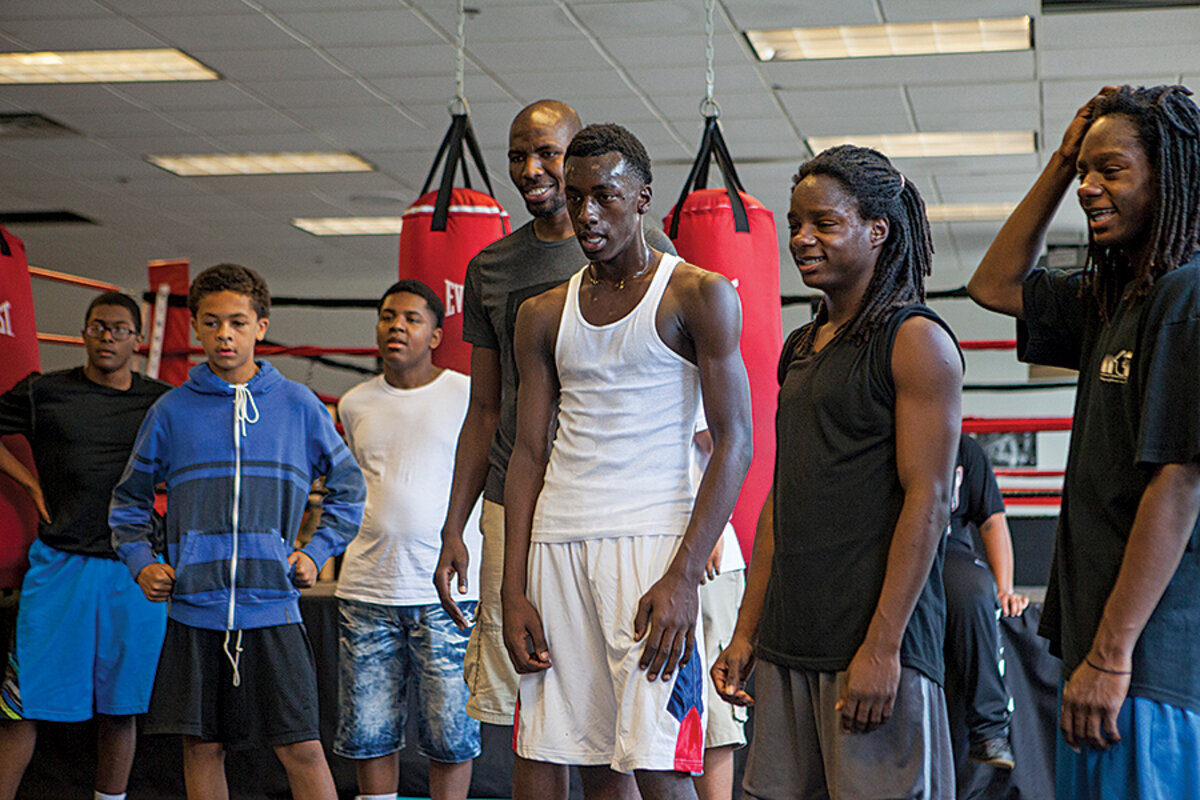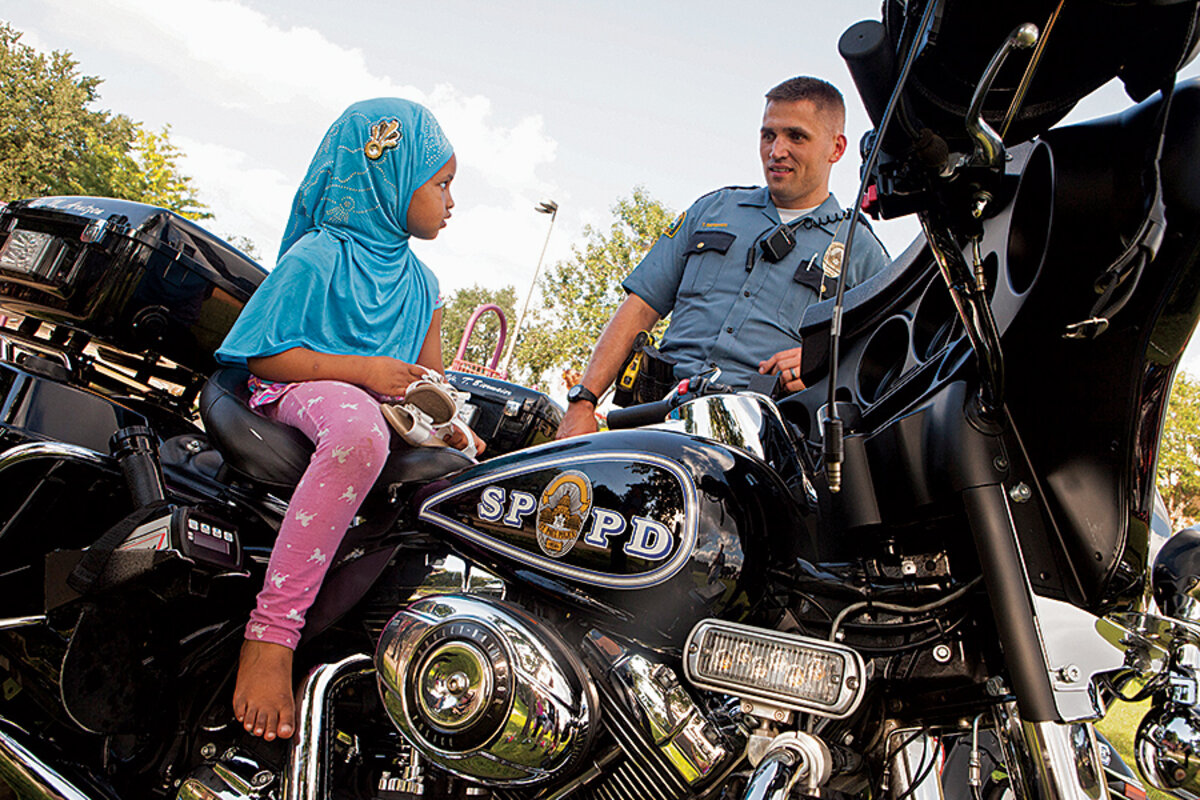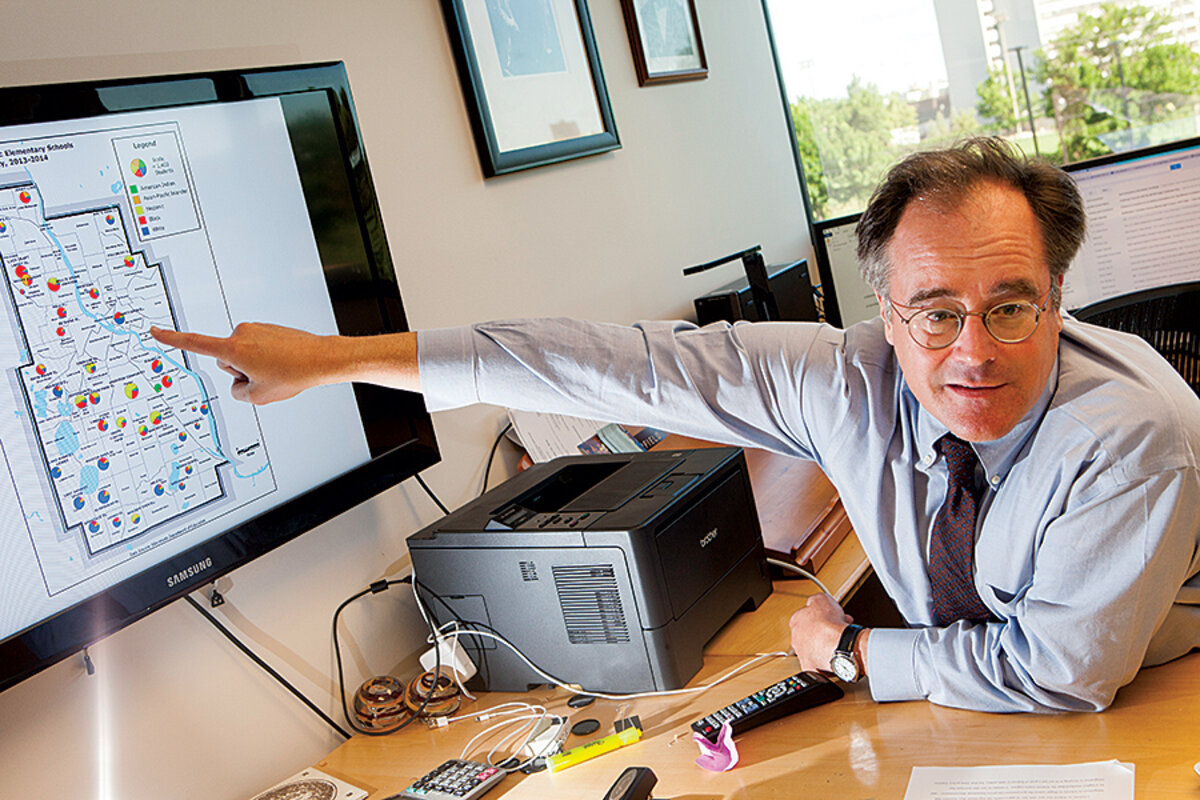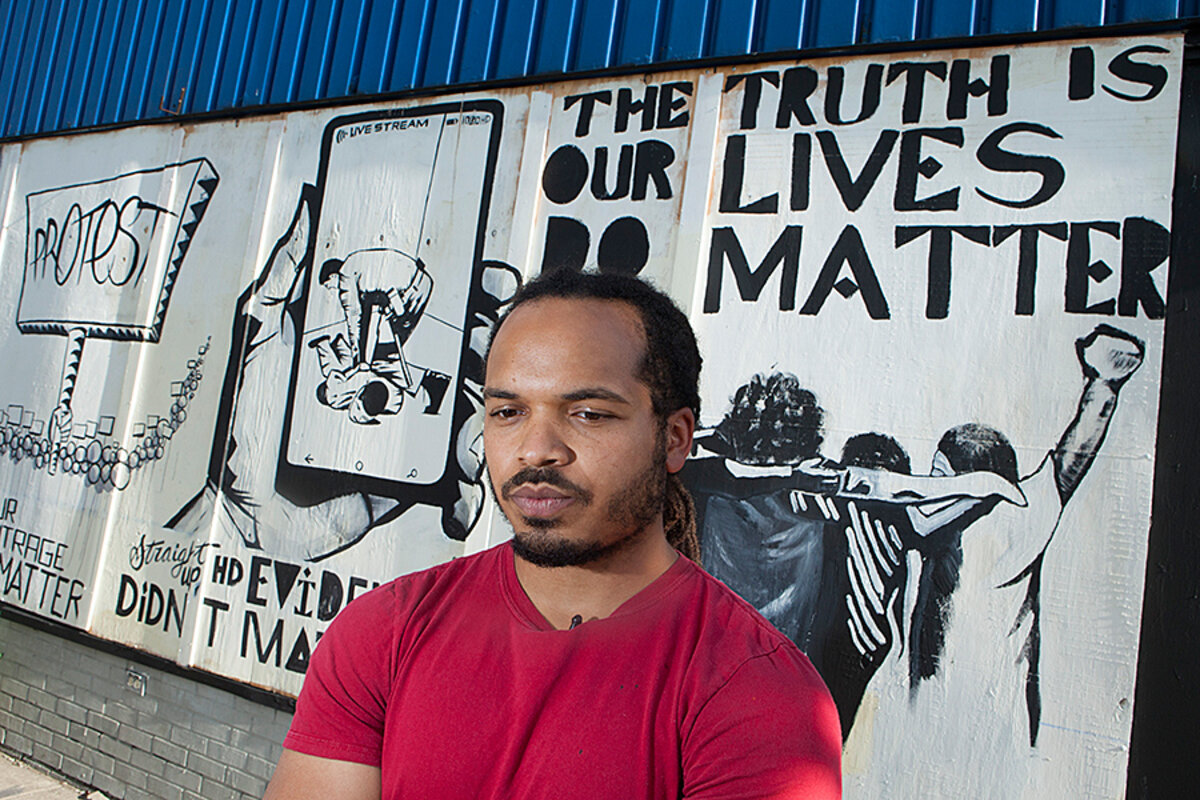The resegregation of America
Loading...
| St. Paul, Minn.
When Michael Kleber-Diggs heard about the police shooting of Philando Castile not far from his house in this Minnesota city, an uncomfortable truth hit him: That could have been me.
Mr. Kleber-Diggs, a risk manager for a logistics company, is black and married to a white woman. The couple has a teenage daughter and lives in a predominantly white neighborhood close to Falcon Heights, the suburb where Mr. Castile had been pulled over for a traffic stop with his girlfriend and her 4-year-old daughter when Police Officer Jeronimo Yanez shot him multiple times.
“Within our house, we have two fairly different experiences,” says Kleber-Diggs, sitting in the parlor of his Craftsman-style home in the Como Park neighborhood. He says he is regularly followed home by squad cars after dropping off his daughter at dance class or visiting his mother, who lives two blocks away from the place where Castile was killed.
His wife, however, has never faced these problems. She grew up in Northfield, south of the Twin Cities, and is a “prototypical Minnesotan,” he says. “Her interaction with the police, her life with the police, is significantly different than mine has been.”
The couple’s different experiences speak to a growing gulf between the lives of white and black people in the Twin Cities – and much of the United States as a whole. While the Minneapolis-St. Paul metropolitan area is known for its prosperity and well-educated population, it also has some of the worst racial disparities in the country.
The state has one of the largest gaps between African-
American and white incarceration rates in the US. Blacks in the Minneapolis-St. Paul region have some of the highest poverty rates among the nation’s large metropolitan areas. And no city in the country has a worse record of race-based mortgage-lending discrimination.
“It’s a tale of two cities,” says Yusef Mgeni, who serves on the board of the St. Paul branch of the National Association for the
Advancement of Colored People (NAACP). “One of them is bright and hopeful and the other one horrific, if you’re poor or a person of color. The evidence is too thoroughly documented to debate.”
Mr. Mgeni says that Castile’s death and the police shooting of Jamar Clark in Minneapolis last November are examples of that “horrific” reality.
But while both President Obama and Minnesota Gov. Mark Dayton called race a key factor in Castile’s death, less attention has been given to the role of another fundamental force in American society – segregation. More than a half century after the civil rights era, many urban neighborhoods and institutions in American life remain unintegrated and, experts say, segregation is a primary driver in creating economic and social disparities and straining relations between police and the communities they serve.
The enduring forms of segregation – and in the case of many schools, resegregation – contribute to mistrust between the races and a lack of understanding and empathy, and can lead to violent encounters between law enforcement authorities and residents. Indeed, researchers and community organizers like Mgeni say that segregation is an often overlooked common denominator in many of the cities that have seen high-profile police shootings in recent years.
“You’re kind of looking at the greatest hits of segregation: Baltimore, Chicago, Minneapolis,” says Myron Orfield, director of the University of Minnesota Law School’s Institute on Metropolitan Opportunity, referring to the police killings of Freddie Gray, Laquan McDonald, and Castile. “They are places where the black and white realities are really different for people for both race and class.”
These different realities can become flashpoints when police officers living in white neighborhoods work in predominantly black neighborhoods. Suspicion and fear sway the thinking of both sides as communities and officers struggle to understand each other.
“When you live in a society where there are really distinct communities on the basis of race, distrust grows and the potential for incidents like this are much higher,” says Mr. Orfield. “In places in the country that are less socially and racially segregated, I think these things are less likely to happen and less likely to have such an enormous outcry if they do.”
In a study coming out this fall, Orfield found that police are much more likely to shoot people of all races in segregated neighborhoods, and they are much more likely to shoot black people in white neighborhoods than anybody else.
“We have a lot of African-Americans who are feeling occupied in their communities by police,” says Natalie Y. Moore, author of “The South Side: A Portrait of Chicago and American Segregation.” Chicago has seen several high-profile police shootings in recent years, including the killing of teenager Laquan McDonald on the city’s South Side.
“Segregation is the common denominator that we see in these communities,” she says. “If we’re going to effectively address race relations, we have to address our separateness.”
That separateness can be seen along the east-west artery of Lake Street in Minneapolis, which becomes Marshall Avenue in St. Paul. The road starts in Cedar-Isles-Dean, an 88 percent white neighborhood on Minneapolis’s west side, and continues east through the predominantly black neighborhood of Philips and the white neighborhood of Longfellow before becoming Marshall Avenue. In St. Paul, the road cuts through the 78 percent white neighborhood of Union Park before ending in Summit-University, a historically black area that is now a more integrated neighborhood.
“Lake Street is a microcosm for the rest of the city in a lot of ways,” says artist and storyteller Jeremiah Bey Ellison. “You could probably see the entire wealth gap driving down this street.”
Mr. Ellison is standing in front of his newest mural, a black-and-white painting on the side of an abandoned warehouse on Lake Street in Minneapolis. He painted the mural with a group of nine other artists the night after Castile was killed.
In bold, stylized letters the piece demands: “What do we tell our children when education didn’t matter, compliance didn’t matter, age didn’t matter, your guilt/innocence didn’t matter, our outrage didn’t matter, straight up HD evidence didn’t matter?”
The question speaks to Ellison’s frustration with racism and segregation in the place he calls home. Ellison grew up in a politically active household in north Minneapolis, a neighborhood with a large black and Asian population. His father is US Democratic Rep. Keith Ellison, the first African-American to be elected to the House of Representatives from Minnesota and the first Muslim to be elected to Congress.
“I was raised in this bubble of Minneapolis, which is a city that was mostly white. But from my vantage point as a 6-year-old or a 7- or 8-year-old, it was a very black and brown city,” he says of the neighborhood where he grew up.
Ellison says that it wasn’t until high school that he started to see the city differently. He went to a private college preparatory school in another neighborhood where he was one of only two young black men in his graduating class.
“In high school, I came up against a lot more overt racism that started to instill [in me] a good degree of resentment and distrust that maybe wasn’t there before,” says Ellison. “Anything from rates of suspension, to interpersonal dynamics between you and your classmates, to the curriculum not fully reflecting the history that you know about yourself back to you. Those are the ways in which I really feel like I started to relate to white people in a different way, when I got to an age where I started to recognize those things and compare those things to the neighborhood that I was going back to each day and saying, ‘There’s a large discrepancy here between the history I know and what I’m learning at school.’ ”
When Jamar Clark was killed last November by Minneapolis police officers, that discrepancy became even clearer. Mr. Clark was shot just four blocks away from the house Ellison grew up in and he used to party in the row houses there. Ellison decided he needed to do something. He joined the scores of protesters who camped out in front of the Fourth Precinct police station for weeks.
After police killed Castile just eight months later, Ellison again went out to the large protest that was forming, this time outside the governor’s mansion in St. Paul. But ultimately Ellison decided he wanted to make a bolder statement with his artwork.
“We’re trying to tell the story of how people feel and how out of control people feel and unsafe,” he says. “There’s a general feeling that if things don’t change, the language we’re using is going to move away from reform and toward [advocating the abolition of police forces altogether]. They’re that fed up.”
The gap between experiences of blacks and whites in the Twin Cities wasn’t always so wide, which is one reason there is so much frustration here. As in so many other cities across the US, segregation has been partly the product of conscious policy decisions by government officials.
“We have a myth – I call it ‘de facto segregation,’ ” says Richard Rothstein, a research associate at the Economic Policy Institute, a think tank in Washington, D.C., and author of the report “The Making of Ferguson.” “As if all the patterns of racial segregation across the country just sort of happened by accident. And that’s a myth.”
While personal choices may have contributed to segregation, with families choosing to live in places where their neighbors looked like them, Mr. Rothstein says that government policies have been the biggest driver for the incredible levels of separateness that are seen today. Early on, the federal government built separate public housing projects for African-Americans and whites in urban areas.
Then, the government subsidized the movement of white families to the suburbs through a Federal Housing Administration policy.
In the Twin Cities, progressive government policies in the 1960s and ’70s helped the region avoid some of the extreme segregation that other cities experienced, and it was poised to become one of the most integrated metropolitan areas in the country. A statewide rule required the radical integration of schools and helped prevent any backsliding toward racial isolation. Additionally, under a fair housing plan, both the Twin Cities and their surrounding suburbs were required to build affordable housing, meaning that poor blacks were not locked into living in the inner city. During this period of integration, the many benefits Minnesotans enjoyed, such as high education rates, were shared across races and economic strata.
But changes to Minnesota’s school desegregation rule and fair housing program in the 1990s led to rapid declines in integration during the past two decades. Suburban politicians successfully pressured the government to back away from its fair housing plan and moved affordable housing to poorer, urban areas. A change in how the Minnesota attorney general interpreted the meaning of the federal equal protection clause also made the state’s school integration strategy unconstitutional.
“We now have the largest disparities in education, in employment, in mortgage lending, in incarceration, and in health between black and white people in the United States,” says the University of Minnesota’s Orfield. “And they didn’t exist when we were integrated.”
In 2000, the Twin Cities had 11 schools that were made up of more than 90 percent nonwhite students. By 2009, that number had risen to 83. Similarly, the portion of low-income black residents living in high-poverty census tracts jumped from 13 percent in 2000 to 19 percent in 2012.
In contrast, cities like Seattle and Portland, Ore. – which have a similar racial makeup to that of the Twin Cities – have not dramatically increased segregation levels in the same period. Portland went from zero to two schools that were more than 90 percent nonwhite between 2000 and 2009; Seattle went from 14 to 25. The West Coast cities also saw a decline in the number of low-income black families living in high-poverty census tracts in that period.
The image of Minnesota as the land of milk and honey may vanish altogether if the growing problems of segregation and racial gaps are not addressed. A report by the Metropolitan Council – the government agency responsible for regional planning in the Twin Cities seven-county metropolitan area – predicts an increase in the percentage of people of color in the area from 24 percent in 2010 to 41 percent in 2040.
African-Americans make up the largest community of color in the metropolitan area. As their population grows in the next two decades, the region’s prosperity could decline if disparities in wealth and education are not minimized.
“Racism and segregation hurt white people, too,” says the NAACP’s Mgeni. “They hurt the business community, they hurt people of all ages, races, genders, sexual orientation, the whole nine yards. This is a community-wide public health life-and-death issue.”
The days of segregated lunch counters and public restrooms, of course, have been relegated to black-and-white photographs of the past. But more subtle forms of black and white separation persist, including in many of the nation’s urban neighborhoods.
While an analysis of census data by the Brookings Institution in Washington last year found a modest decline in black-white segregation nationwide over the past decade, the levels were still high. According to the report, “more than half of blacks would need to move to achieve complete integration.” School segregation has become even worse in recent decades. A report by the US Government Accountability Office earlier this year found that the percentage of public schools with high concentrations of poor and black or Hispanic students has nearly doubled since 2000.
The difficulty in reducing segregation is rooted in part in society’s reluctance to admit that it’s a self-made problem. “There are many things we can do [to reduce segregation], but we’re not going to do them so long as we have the myth that segregation developed without intent and that it happened by accident, and therefore that it can only un-happen by accident,” says Rothstein. “It’s going to require policy as conscious to desegregate as it was to segregate.”
He says the little movement cities have seen away from segregation in recent years has been mostly the result of lawsuits and official complaints. In Maryland, for example, Baltimore County resolved a federal housing discrimination complaint in March, which alleged that public housing was explicitly segregating African-Americans from whites. The negotiated settlement requires the county to help 2,000 families use rent vouchers in more integrated areas. The county also agreed to spend $30 million to build 1,000 homes for low-income black families in prosperous neighborhoods.
In the Twin Cities, residents are also pushing the government to change policies around segregation. Last November, attorneys representing seven families and a community group sued the state of Minnesota for failing to desegregate schools in Cruz-Guzman v. State of Minnesota. Then this May, Minneapolis and St. Paul negotiated voluntary compliance agreements with neighborhood groups that had filed federal complaints stating that the cities were contributing to racial and ethnic segregation.
Not everyone, though, believes the Twin Cities is an egregious symbol of black and white separation. Libby Starling of the Metropolitan Council, for one, says Minnesotans are trying to deal with the broader economic and social issues underlying the problem rather than just thinking about segregation and integration.
She says that the council takes the “balanced approach” advocated by the US Department of Housing and Urban Development in its work to close economic gaps in the Twin Cities.
“It’s not an either-or conversation [with segregation or integration], but really looking at how we expand choices for all residents across the region,” says Ms. Starling, who serves as the council’s manager of regional policy and research. “Particularly so that communities of color feel like they have the option to stay in connected communities that have the churches or the grandmas or the relationships. Or to move to suburban communities that have more predominantly white schools. So whatever those choices are, all should be good and viable options.”
University of Minnesota’s Orfield argues, however, that existing government policies and the high cost of housing in white neighborhoods mean that poor black families actually have few choices about where they can live. Moreover, Orfield argues that since the Metropolitan Council receives federal housing funds, it has an obligation to address segregation in the Twin Cities.
“It’s forbidden from perpetuating patterns of racial segregation,” Orfield says. “They don’t have to solve it all at once,” he adds, “but they can’t allow patterns of segregation to [persist], and they can’t let them grow worse.”
While governments debate the various philosophical approaches to dealing with segregation, police departments are under pressure to improve their interaction with communities of color shift by shift. One potential way to do it: by hosting a barbecue.
On a humid summer evening, hot dogs sizzle on grills in Hazel Park on St. Paul’s east side. Officers from the city police department, dressed in their uniform blues, wield the spatulas and play softball with elementary school students. They hand out food and chips to the youths and dance the cha-cha with people from the neighborhood – a mixed group of African-Americans, Latinos, and Hmong.
In one corner of the park, residents feed apples to a police horse. In another, they climb inside a brown armored personnel carrier that was made especially for the department. The event was put on by a new community outreach unit the St. Paul police launched in June, in the wake of tensions with residents after the Castile shooting.
“More often than not, regardless of what organization we’re representing, we have so much more in common than we do not have in common,” St. Paul Police Chief Todd Axtell says in an interview at the event. “We all have the same goals in life. We want peace, we want prosperity, we want equality, we want safety. And those are the things that we have in common. But how we accomplish that is sometimes the challenge.”
The St. Paul Police Department is also supporting a group of community ambassadors who walk the streets of high-crime areas at night and try to defuse fights and connect young people to much-needed social services.
Minneapolis is instituting changes, too. Last year, the city became one of six pilot sites for the Department of Justice’s National Initiative for Building Community Trust and Justice. The program aims to help Minneapolis police officers reduce bias and support reconciliation with communities.
Yet the question is whether these initiatives will actually improve day-to-day dealings with residents. Sitting in his house in St. Paul, Kleber-Diggs shares the police officials’ hope for unity. He recalls walking with his wife shortly after Castile was shot and running into some of his white neighbors.
“They were devastated and troubled. They wanted to know, what should we do? How should we respond to this? And we hugged,” says Kleber-Diggs. “I think that in our day-to-day lives, in our efforts to keep the bills up and raise families and advance in careers ... I think we don’t dwell on our neighbors’ difficulties or what makes their life different from ours. I know that’s true of me, too. It’s sad, but it’s true. Events like this have the effect of pulling you away from that and slowing you down. They give you the opportunity to see things as they are and ... work to change them.”
Kleber-Diggs doesn’t want to leave his home in Como Park, or the Twin Cities, where he has lived since 1990. The area is rich with culture, something that appeals to this creative and thoughtful man. He is determined to keep his daughter safe and fight for a world where the color of people’s skin doesn’t determine how police treat them. He’s optimistic about Minnesota’s potential for change and sees a desire in his neighbors to address racism and segregation.
“I think that the same instinct that compels people to want to live in a community they admire is the same instinct that says we can’t have this here,” says Kleber-Diggs. “There are a lot of people, a lot of white people, who are active and engaged in Falcon Heights and who are meeting in front of that city council. There are a lot of black people who are standing in highways here. There are a lot of white people who are standing in highways here. And I think that that’s because we don’t want [racism and segregation] here.”









